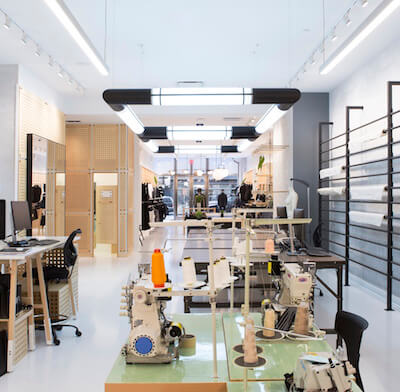“We don’t use the word ‘athleisure,’” Lauren Bille corrects me as we sit inside her WeWork Chelsea office. What is part of the Lululemon vernacular, however, is “sweat,” as well as “no sweat.”
“No sweat” applies to clothing found at Lululemon Lab, which Bille, brand and community manager, religiously reps. Today she’s wearing a Lab sweatshirt with a cool, downtown New York vibe that seems far off from the traditional yoga wear Lululemon is known for.
The Lab, a conceptual retail space within the Lululemon brand, acts as an incubator for design and innovation. The concept itself is not new—the first Lab opened in Vancouver about seven years ago. But the New York Lab, whose Bond Street location opened last week, has its own unique and hyperlocal perspective, all “while maintaining a consistent global purpose.”
“The life of a New Yorker is very different from that of someone who lives in Vancouver,” says Bille. “We know New York is fashion-driven, so you will see riskier silhouettes and shapes. New York is also full of creatives—if they aren’t headed to SoulCycle, they might be riding their bike to go pick up art supplies. We are designing clothes for someone with a fully active life.”

Although the collections vary depending on the Lab location and its surrounding community, the design process functions the same. Both the Vancouver and New York City locations employ one head designer who initiates the development of their respective collections. The designers then begin their process by drawing inspiration from the overarching theme for Lululemon’s main line.
“We’ve been thinking about clothes that function for people who move in a city that moves,” Bille says. “That could be anything to anyone…it doesn’t have to be about exercise.”
Once Lululemon lands on a theme, the Lab teams create physical mood boards with images that reflect the concept. Ultimately, all Lab departments—both design and marketing—use the mood boards as inspiration when it comes to strategy.
The designers then work closely with the merchant to determine how many styles of each category need to be developed depending on the timeline of in-store product launches. Digital specs of the collection are finalized and passed to a technical designer who is tasked with finding a way to make the measurements work so the sample maker is able to create a sample of each style. The approved samples make their way to the factories, where they are duplicated in the predetermined colorways. Finally, quantities come back to the Lab floor where they are tagged and prepped for shoppers.
The authentically inspired and efficiently executed product development is impressive, but the most attractive quality of the process is the level of transparency that accompanies it.
Located within the Lab retail store, you’ll find the brand’s headquarters. Fully open to the public, shoppers have the opportunity to wander through the offices and witness the in-house sample maker hard at work, while the design team focuses on the upcoming collection under visually accessible mood boards.

The open-door policy translates into marketing efforts, in terms of the types of experiences offered to shoppers. Appealing to the downtown New Yorker means attracting creatives whose shared interests include innovation and collaboration. This means dinner parties that inspire thought-provoking conversations as opposed to yoga workshops. A Bond Street block party is even in the works.
“If you’ve lived in New York, you’ve probably had a really amazing life by the time you’re 30,” says Bille, “which makes it hard to be surprised and impressed. We are thoughtfully trying to create something new.”
Who is the Lululemon team creating something new for? Both the loyal customer who already has the Lab on her radar, as well as “someone who hasn’t been thinking about Lululemon.”
Although the markets differ, the two brands are meant to coincide, meaning that many elements of the Lab business maintain experiential and design factors that reflect Lululemon’s values, the most notable being the concept of “guest” (refers to customers) versus “educator” (refers to sales people).
This terminology empowers the Lab team to focus on the educational component of selling while treating those who walk through the retail doors as if they were guests entering a home. The strategy inspires a trusting relationship and attracts a valuable, long-term customer.
Even more interesting than the concept of guest versus educator is the organizational system that requires everyone on the Lab team, including designers, merchants, etc. to spend time on the sales floor every week. The goal is not only to allow easy access to customer feedback, but also inspire an autonomous work environment fueled by pride, as each team member experiences complete ownership over their business.
“The Lab is very much an intrapreneurship,” says Bille. “We have the safety net of a larger company, but everything we are doing has never been done before. It feels very much like we’re working at a startup, and we’re all very excited to be a part of it.”

Photos: Lululemon Athletica




